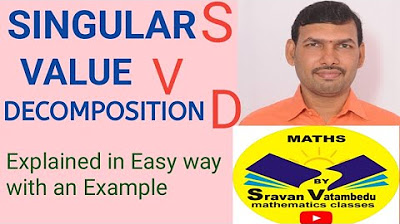Singular Value Decomposition (SVD): Mathematical Overview
Summary
TLDRThis video delves into Singular Value Decomposition (SVD), a fundamental matrix factorization technique in numerical linear algebra. It explains how to compute and interpret SVD in the context of data matrices, like those derived from images or physical systems. The presenter introduces the concept of decomposing a data matrix X into three matrices: U, Sigma, and V^T, highlighting the properties of unitary matrices and the significance of the diagonal, hierarchically ordered singular values. The video promises to explore the computation, interpretation, and applications of SVD for data approximation, modeling, and analysis in future segments.
Takeaways
- 📚 Singular Value Decomposition (SVD) is a crucial matrix decomposition technique in numerical linear algebra.
- 🌟 The data matrix X can be decomposed into three matrices: U, Sigma, and V transpose (UT * Σ * VT).
- 🔍 U and V are unitary (orthogonal) matrices, meaning their columns are orthonormal and provide a complete basis for the vector space.
- 📊 Sigma is a diagonal matrix with non-negative, hierarchically ordered singular values, indicating the importance of each component.
- 🖼️ Examples of data matrices include collections of images reshaped into column vectors or snapshots of a physical system over time.
- 🧬 The columns of U, known as left singular vectors, can represent 'eigenfaces' in image data or 'eigenflows' in physical systems.
- 🔄 V transpose represents the mixtures or time series of these eigenvectors, showing how they combine to form the original data points.
- 🔑 SVD is computationally efficient and can be easily performed in various programming languages like MATLAB, Python, and R.
- 🔍 The decomposition is guaranteed to exist and is unique up to the sign of the singular vectors, which can be flipped without affecting the result.
- 🛠️ SVD has applications in approximating data matrices, building models, linear regression, and principal components analysis.
- 📈 The ordering of singular values allows for the identification and potential omission of less significant components for data simplification and noise reduction.
Q & A
What is the Singular Value Decomposition (SVD)?
-Singular Value Decomposition is a matrix decomposition technique used in numerical linear algebra, where a given matrix X is decomposed into the product of three matrices: U, Σ (Sigma), and V transpose.
What are the types of matrices involved in SVD?
-In SVD, U and V are unitary (or orthogonal) matrices, and Σ is a diagonal matrix containing the singular values.
How can a data matrix X be represented in terms of column vectors?
-A data matrix X can be represented as a collection of column vectors, such as X1, X2, ..., XM, where each column vector corresponds to an individual data point or measurement.
What is an example of how a data matrix X could be formed using images?
-A data matrix X can be formed by reshaping images of faces into tall skinny column vectors, where each face image is converted into a column vector with a million dimensions (assuming a megapixel image).
How can the concept of a data matrix be applied to a physical system?
-In a physical system, such as fluid flow, the data matrix X can be formed by reshaping snapshots of the flow field at different times into column vectors, representing the state of the system as it evolves.
What is the significance of the columns of U in the context of SVD?
-The columns of U, also known as the left singular vectors, are orthogonal and hierarchically ordered, representing the most significant variations in the data matrix X in terms of their ability to describe the data.
What does the diagonal matrix Σ represent in SVD?
-The diagonal matrix Σ contains the singular values of the data matrix X, which are non-negative and ordered in decreasing magnitude, representing the importance of the corresponding columns of U and V.
How are the columns of V interpreted in SVD?
-The columns of V, or the right singular vectors, when transposed, represent the mixtures or combinations of the columns of U that make up the original data vectors in X, scaled by the singular values.
What is the computational advantage of SVD?
-SVD is computationally efficient and can be easily computed in various programming languages like MATLAB, Python, and R using built-in functions.
Why is SVD guaranteed to exist and what does its uniqueness imply?
-SVD is guaranteed to exist for any matrix X, and it is unique up to the sign of the singular vectors, meaning the decomposition is consistent but the signs of U and V can be flipped without affecting the result.
How can SVD be used in practical applications such as linear regression or principal components analysis?
-SVD can be used to approximate the data matrix X, build predictive models, perform linear regression, and conduct principal components analysis by focusing on the dominant singular values and their corresponding vectors.
Outlines

This section is available to paid users only. Please upgrade to access this part.
Upgrade NowMindmap

This section is available to paid users only. Please upgrade to access this part.
Upgrade NowKeywords

This section is available to paid users only. Please upgrade to access this part.
Upgrade NowHighlights

This section is available to paid users only. Please upgrade to access this part.
Upgrade NowTranscripts

This section is available to paid users only. Please upgrade to access this part.
Upgrade NowBrowse More Related Video

SINGULAR VALUE DECOMPOSITION (SVD)@VATAMBEDUSRAVANKUMAR

Image Compression with Python

Singular Value Decomposition (SVD) and Image Compression

Week 3 Lecture 13 Principal Components Regression

Diketahui: (-1 4 -2 3)+(4 -5 -3 2)=(2 -1 -4 3)(2p 1 1 q+1). Nilai p+q= ...

What Linear Algebra Is — Topic 1 of Machine Learning Foundations
5.0 / 5 (0 votes)